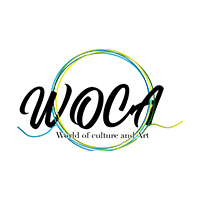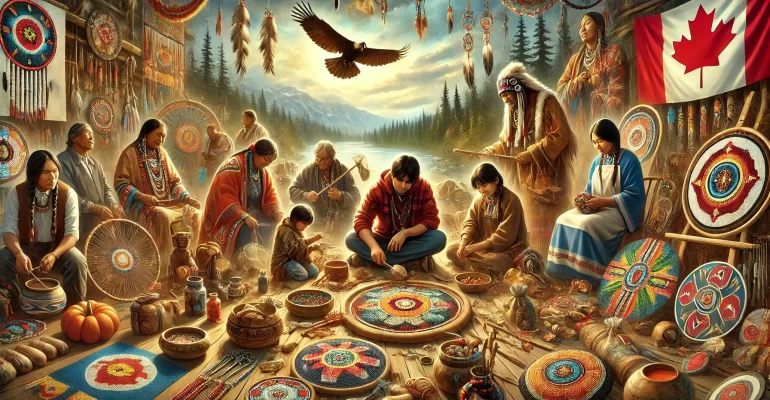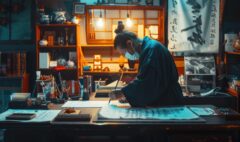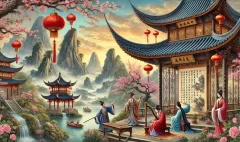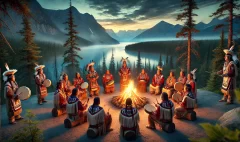Empowering Creativity: Your Guide to Supporting Indigenous Artisans in Canada
Empowering Creativity: Your Guide to Supporting Indigenous Artisans in Canada
Hello, art lovers and supporters of Indigenous cultures! Today, we’re diving into the vibrant world of Indigenous artisans in Canada and exploring how we can all play a part in supporting the incredible artisans who create it. Here at WOCA Group, we believe that art has the power to bridge cultures, tell stories, and create positive change. So, let’s embark on this colorful journey together and discover how we can uplift Indigenous artisans and their beautiful creations!
Why Supporting Indigenous Artisans Matters
Before we jump into the ‘how’, let’s talk about the ‘why’. Supporting Indigenous artisans is important for so many reasons:
- Cultural Preservation: When we support Indigenous art, we’re helping to keep ancient traditions and skills alive.
- Economic Empowerment: Buying from Indigenous artisans provides income that supports families and communities.
- Education: Indigenous art teaches us about diverse cultures, histories, and worldviews.
- Reconciliation: Supporting Indigenous artisans is one way to build positive relationships between Indigenous and non-Indigenous people.
- Artistic Diversity: Indigenous art adds unique and valuable perspectives to Canada’s cultural landscape.
- Environmental Stewardship: Many Indigenous artisans use sustainable practices that respect the environment.

“When you support an Indigenous artist, you’re not just buying a beautiful object,” explains Elder Mary Creativespirit. “You’re investing in our cultures, our communities, and our future.”
Understanding Indigenous Art Forms
Indigenous art in Canada is incredibly diverse. Here’s a quick overview of some common art forms you might encounter:
- Beadwork: Intricate designs created with tiny beads, often on clothing or accessories.
- Carving: Sculptures made from wood, stone, antler, or other materials.
- Painting: From traditional hide paintings to contemporary canvas works.
- Basketry: Woven containers made from materials like cedar bark or sweetgrass.
- Textile Arts: Including weaving, quilting, and clothing design.
- Jewelry Making: Using materials like silver, copper, beads, and natural elements.
- Pottery: Clay vessels, often decorated with traditional designs.
- Digital Arts: Many Indigenous artists are embracing new technologies in their work.

Each of these art forms has its own techniques, materials, and cultural significance. When you’re looking to support Indigenous artisans, it’s helpful to learn a bit about the type of art you’re interested in.
Where to Find Authentic Indigenous Artisans
Now that we know why it’s important and what to look for, where can we find authentic Indigenous art? Here are some great places to start:
- Indigenous-Owned Galleries: Many Indigenous communities have their own art galleries that showcase local artists.
- Cultural Centers: These often have gift shops featuring work by Indigenous artisans.
- Pow Wows and Festivals: These events usually include marketplaces where artisans sell their work.
- Online Marketplaces: There are several websites dedicated to selling authentic Indigenous art.
- Museums: While you can’t usually buy art here, museum shops often sell work by Indigenous artisans.
- Art Cooperatives: Some Indigenous communities have cooperatives that support local artists.
- Direct from Artists: Many Indigenous artists have their own websites or social media where you can buy directly.

At WOCA Group, we regularly host Indigenous art markets where you can meet artisans in person and purchase their work. It’s a wonderful way to connect with the artists and learn about their creations firsthand!
Online Marketplaces: Shopping from Home
In today’s digital world, you don’t always have to leave home to support Indigenous artisans. Here are some reputable online marketplaces:
- Indigenous Arts & Stories (www.our-story.ca): Features work by emerging Indigenous artists and writers.
- Aboriginal Artworks (www.aboriginalartworks.com): Offers a wide range of Indigenous art from across Canada.
- Inuit Art Foundation (www.inuitartfoundation.org): Specializes in art from Inuit communities.
- Native Art in Canada (www.native-art-in-canada.com): Showcases work by First Nations, Métis, and Inuit artists.
- Beyond Buckskin Boutique (www.beyondbuckskin.com): Focuses on Indigenous-made fashion and accessories.
Remember, when shopping online, always check the website’s About page to ensure they have ethical practices that support Indigenous artisans.
Art Festivals and Events: Experience the Culture
There’s nothing quite like experiencing Indigenous art and culture in person. Here are some major events across Canada where you can do just that:
- Indigenous Fashion Week Toronto: Showcases Indigenous fashion designers and textile artists.
- Manito Ahbee Festival (Winnipeg): Includes an Indigenous marketplace and art challenge.
- Great Northern Arts Festival (Inuvik): Features artists from across the Arctic.
- Santa Fe Indian Market (while not in Canada, many Canadian Indigenous artists participate): One of the largest Indigenous art markets in North America.
- imagineNATIVE Film & Media Arts Festival (Toronto): Focuses on Indigenous-made films and digital art.

WOCA Group often organizes trips to these events, providing a chance for our community members to experience Indigenous art and culture together. Keep an eye on our event calendar for upcoming opportunities!
Understanding Authenticity: Know What You’re Buying
When supporting Indigenous artisans, it’s important to ensure you’re buying authentic work. Here’s what to look for:
- Artist Information: Authentic pieces should come with information about the artist, including their name and nation.
- Materials: Learn about traditional materials used in the type of art you’re interested in.
- Certificates of Authenticity: Many Indigenous artworks come with these certificates.
- Fair Pricing: If a price seems too good to be true, it might not be authentic Indigenous art.
- Ask Questions: Don’t be afraid to ask about the artwork’s origin and meaning.

“Authentic Indigenous art carries our stories and our spirit,” says Tom Authenticraft, an Indigenous artisan. “When you buy authentic, you’re truly connecting with our cultures.”
The Impact of Your Support: Real Stories of Indigenous Artisans
Let’s look at how supporting Indigenous artisans can make a real difference:
- Sarah Beadmaster, a Cree beadwork artist, shares: “When people buy my beadwork, it doesn’t just help me financially. It allows me to keep practicing and teaching this art form that’s been in my family for generations. It’s about cultural survival.”
- John Carvinghand, a Haida carver, tells us: “Selling my carvings has allowed me to work full-time as an artist. This means I can take on apprentices and pass on our traditional carving techniques to the next generation.”
- Mary Weaverwoman, an Anishinaabe basket weaver, explains: “The income from my baskets helps support my whole family. But more than that, it’s allowed me to start a weaving circle in my community, where we gather to weave, share stories, and keep our traditions alive.”

These stories show that when we support Indigenous artisans, we’re not just buying art – we’re investing in cultural continuity, community well-being, and the passing down of ancient knowledge.
Respecting Indigenous Art: What to Know
As we support Indigenous artisans, it’s crucial to do so respectfully. Here are some important things to keep in mind:
- Cultural Significance: Many Indigenous artworks have deep cultural or spiritual meanings. It’s important to appreciate this, even if we don’t fully understand it.
- Appropriate Use: Some items, like sacred objects or ceremonial pieces, may not be appropriate for non-Indigenous people to buy or use.
- Copyright: Indigenous designs are often protected by copyright. It’s not okay to reproduce them without permission.
- Fair Compensation: Be willing to pay fair prices that reflect the skill, time, and cultural knowledge that goes into creating Indigenous art.
- Learning: Take time to learn about the art you’re buying and the culture it comes from.

“We’re happy to share our art with the world,” says Elder Lisa Respectfulheart. “But we ask that people remember these aren’t just pretty objects – they’re pieces of our culture and identity.”
WOCA Group’s Commitment to Indigenous Artisans
Here at WOCA Group, we’re dedicated to supporting Indigenous artisans in our community. Here’s how we do it:
- Indigenous Art Markets: We host regular markets where Indigenous artisans can sell their work directly to the public.
- Workshops: We organize workshops led by Indigenous artisans, where community members can learn traditional art techniques.
- Youth Mentorship: We connect young Indigenous people interested in art with experienced artisans for mentorship.
- Online Showcase: Our website features a gallery of local Indigenous artisans and their work.
- Educational Events: We hold talks and exhibitions to educate our community about Indigenous art and cultures.
“WOCA Group has been a great support,” says Maria Paintbrush, a local Indigenous painter. “Their events have helped me reach new customers and connect with other artists. It’s like a bridge between our Indigenous art community and the wider public.”

How You Can Get Involved
Want to join WOCA Group in supporting Indigenous artisans? Here are some ways you can get involved:
- Attend Our Events: Come to our Indigenous art markets, workshops, and exhibitions.
- Volunteer: Help us organize and run our Indigenous art events.
- Spread the Word: Share information about Indigenous artisans and events on social media.
- Learn and Share: Take part in our educational events and share what you learn with others.
- Buy Indigenous Art: Whether through our events or elsewhere, consider purchasing Indigenous art for gifts or your home.
Beyond Buying: Other Ways to Support
Supporting Indigenous artisans isn’t just about buying art. Here are some other important ways to show support:
- Visit Museums: Many museums have excellent collections of Indigenous art. Your visits support these institutions.
- Follow on Social Media: Many Indigenous artisans share their work and process on platforms like Instagram.
- Advocate: Support policies that protect Indigenous intellectual property rights.
- Educate Yourself: Read books, watch documentaries, and attend talks about Indigenous art and culture.
- Donate: Consider donating to organizations that support Indigenous artists and cultural preservation.
Looking to the Future: The Next Generation of Indigenous Artisans
As we support today’s Indigenous artisans, it’s also important to think about the future. Many communities are working hard to ensure traditional art forms are passed down to younger generations. Here’s how this is happening:
- School Programs: Some Indigenous schools are incorporating traditional arts into their curriculum.
- Youth Workshops: Many communities offer art workshops specifically for Indigenous youth.
- Mentorship Programs: Experienced artisans are paired with young people interested in learning.
- Modern Twists: Young Indigenous artists are finding ways to blend traditional techniques with contemporary styles.
- Digital Platforms: Social media and online marketplaces are giving young Indigenous artisans new ways to share and sell their work.

“Teaching our young people about our art forms is so important,” says Tom Futurecrafter, who runs youth workshops in his community. “It’s not just about creating beautiful objects – it’s about passing on our stories, our values, and our connection to the land.”
Why Supporting Indigenous Artisans Matters & Understanding Indigenous Art Forms
Supporting Indigenous artisans is crucial for preserving cultural heritage, empowering communities economically, and promoting artistic diversity. When we support Indigenous art, we’re not just buying beautiful objects; we’re investing in the continuity of ancient traditions and skills. This support helps keep Indigenous cultures vibrant and allows artists to pass their knowledge to future generations.
Indigenous art forms in Canada are incredibly diverse, reflecting the rich cultural tapestry of First Nations, Inuit, and Métis peoples. These art forms include beadwork, carving, painting, basketry, textile arts, jewelry making, pottery, and even digital arts. Each art form has its own techniques, materials, and cultural significance. For example, beadwork often tells stories through intricate designs, while carvings might represent important spiritual beliefs or family histories.

Where to Find Authentic Indigenous Art & Online Marketplaces: Shopping from Home
Finding authentic Indigenous art can be an exciting journey. Indigenous-owned galleries, cultural centers, and pow wows are excellent places to start. These venues often provide opportunities to meet artists directly and learn about their work firsthand. Many communities also have art cooperatives that support local artists.
In the digital age, online marketplaces have become important platforms for Indigenous artisans. Websites like Indigenous Arts & Stories, Aboriginal Artworks, and the Inuit Art Foundation offer a wide range of authentic Indigenous art that you can purchase from the comfort of your home. When shopping online, it’s important to research the marketplace to ensure they have ethical practices that support Indigenous artisans fairly.
Art Festivals and Events: Know What You’re Buying
Attending Indigenous art festivals and events is a wonderful way to immerse yourself in the culture and meet artisans in person. Events like Indigenous Fashion Week Toronto, the Manito Ahbee Festival in Winnipeg, and the Great Northern Arts Festival in Inuvik offer rich experiences where you can see art being created, participate in workshops, and purchase directly from artists.

When buying Indigenous art, understanding authenticity is crucial. Authentic pieces should come with information about the artist, including their name and nation. Learning about traditional materials and techniques can help you recognize genuine works. Many authentic pieces come with certificates of authenticity. If a price seems too good to be true, it might not be authentic Indigenous art. Don’t hesitate to ask questions about the artwork’s origin and meaning – most artists are happy to share the stories behind their creations.
Wrapping Up: The Power of Your Support
Remember, every time you support an Indigenous artisan – whether by buying their work, attending an event, or simply learning about their art form – you’re not just getting a beautiful piece of art. You’re becoming part of a story that stretches back thousands of years and continues into the future. You’re helping to ensure that Indigenous voices and visions continue to enrich our world. So, the next time you see a piece of Indigenous art that speaks to you, remember the power you have to make a difference. Whether it’s a tiny pair of beaded earrings or a massive carved sculpture, your support matters.
Now it’s your turn! Have you ever purchased a piece of Indigenous art? What was your experience like? Or maybe you have a question about how to start supporting Indigenous artisans? Share your thoughts, experiences, or questions in the comments below. And don’t forget to check out WOCA Group’s upcoming Indigenous art events – we’d love to see you there! Let’s keep the circle of support growing, ensuring that the beautiful traditions of Indigenous art continue to thrive and inspire for generations to come!
